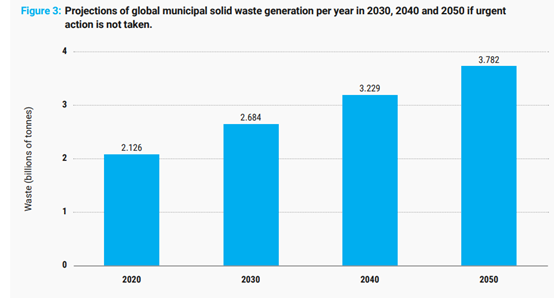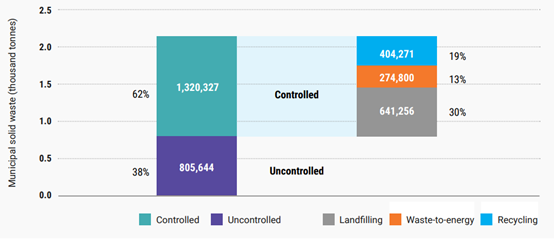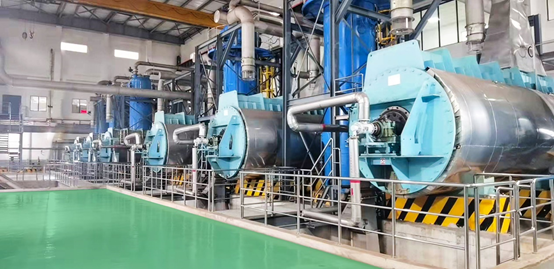

BLOG
Global Waste Management: Challenges, Practices, and Future Outlook
Global Waste Management: Challenges, Practices, and Future Outlook
14 April 2025
According to the Global Waste Management Outlook 2024 (GWMO 2024) report published by the United Nations Environment Programme, the global generation of municipal solid waste reached approximately 2.01 billion tonnes in 2020 and is projected to increase to 3.78 billion tonnes by 2050.

Disposal Methods: 30% Landfilled, 19% Recycled, 13% Incinerated (for energy recovery)
38% of waste is not properly managed, while the remaining 62% is under controlled treatment (about 30% landfilled, 13% incinerated for energy recovery, and only 19% recycled).

Environmental Hazards: The Triple Crisis of Climate Change, Biodiversity Loss, and Pollution
Climate Change
The transport, processing, and disposal of waste emit carbon dioxide and other greenhouse gases, contributing to climate change and air pollution.
Organic waste decomposing in landfills and dumps releases methane, which has a short-term but significant warming potential (UNEP and Climate & Clean Air Coalition [CCAC], 2021).
Open burning of waste emits black carbon, which, when deposited on sea ice, absorbs sunlight and accelerates melting. Black carbon is the second-largest contributor to global warming after CO₂ (NOAA, n.d.).
Biodiversity Loss
Unsustainable waste disposal can introduce hazardous chemicals into soil, water, and air, causing long-term, often irreversible damage to local flora and fauna, and negatively impacting ecosystems and the food chain.
Waste-induced pollution in terrestrial and aquatic ecosystems is considered a leading driver of biodiversity loss (Tovar-Sánchez et al., 2018; UNEP, 2021a).
An estimated 90% of biodiversity loss stems from land use change and resource consumption (International Resource Panel, 2019).
Pollution
Between 400,000 to 1,000,000 deaths annually are linked to diseases caused by poor waste management, including diarrhea, malaria, heart disease, and cancer.
Land-based waste disposal can pollute freshwater through pathogens, heavy metals, endocrine-disrupting chemicals, and other harmful substances.
Open burning of waste releases unintentionally produced persistent organic pollutants (POPs), often referred to as "forever chemicals." These can travel long distances in the air, persist in the environment, bioaccumulate in ecosystems, and severely impact human health and the environment (Stockholm Convention, 2019; WHO, 2020; UNEP, n.d.a).

Waste Management Policies and Regulations
Domestic (China):
• Law of the People’s Republic of China on the Prevention and Control of Environmental Pollution by Solid Waste: Emphasizes waste reduction, recycling, harmless treatment, and the promotion of waste sorting.
• 14th Five-Year Plan for Circular Economy Development: Focuses on plastic pollution management across the value chain, source reduction, and standardized recycling.
• 14th Five-Year Plan for Plastic Pollution Control: Strengthens plastic management from production to consumption, aiming to reduce landfill input.
International:
• EU: The European Strategy for Plastics in a Circular Economy sets recycling targets for 2025, 2030, and 2035. The Packaging and Packaging Waste Regulation (PPWR) mandates that all packaging be reusable, recyclable, or compostable by 2030.
• Wales, UK: The Waste (Amendment) (Wales) Regulations 2023, effective from October 1, 2023, ban landfill disposal of certain recyclable and all wood waste.
• USA: California has strict waste regulations mandating high recycling rates and reduced landfill usage. On April 21, 2023, the EPA and the Biden administration released the Draft National Strategy to Prevent Plastic Pollution, aiming to curb single-use and non-recyclable plastics.
• Germany: The national Circular Economy Strategy targets 2045 goals for increased recycling, waste segregation, and higher use of recycled plastics.
• Japan: Legislation like the Waste Management and Public Cleansing Law has led to high waste incineration rates and advanced recycling, with over 80% of municipal solid waste incinerated.
Global Waste Management Approaches
1. Landfilling
Definition: Organizing and burying waste underground — one of the oldest and most widely used disposal methods.
Key Characteristics:
• Used for non-recyclable or cost-prohibitive waste;
• Requires liners, leachate collection, and gas recovery systems.
Advantages:
• Low cost;
• Mature technology;
• Minimal disruption to daily life if well-located.
Disadvantages:
• High land use;
• Risk of leachate contaminating soil and groundwater;
• Methane emissions worsen the greenhouse effect;
• Land is difficult to reuse post-closure.
Current Usage:
• Still prevalent in developing countries (e.g., India, parts of Africa and Southeast Asia);
• Minimally used in developed nations — Germany has virtually eliminated direct landfill use.
2. Incineration / Waste-to-Energy
Definition: High-temperature oxidation of waste, greatly reducing its volume while recovering energy.
Common Technologies:
• Conventional incinerators with flue gas treatment;
• Cogeneration Waste-to-Energy plants;
• Plasma gasification (advanced).
Advantages:
• Reduces volume by ~90%;
• Recovers heat and electricity;
• Less landfill reliance;
• Suitable for urban areas.
Disadvantages:
• High capital investment;
• Complex emissions control (dioxins, acid gases);
• Residual ash and fly ash require safe disposal.
Current Usage:
• High in Japan, Germany, Sweden, Singapore;
• Rapid expansion in China (e.g., Everbright, Dynagreen);
• Requires robust emissions regulation.
3. Recycling
Definition: Extracting valuable materials through sorting, cleaning, and reprocessing.
Common Items:
• Metals (copper, aluminum, steel);
• Plastics (PET, HDPE);
• Paper, glass;
• E-waste.
Advantages:
• Conserves resources, reduces pollution;
• Supports circular economy;
• Boosts green industries.
Disadvantages:
• Requires robust source segregation;
• Not always economically viable;
• “Downcycling” of contaminated materials is problematic.
Current Usage:
• Top recycling rates: Germany, Sweden, South Korea;
• China promoting sorting to improve recycling rates;
• Japan tightly integrates recycling with industry (e.g., PET bottles into clothing).
4. Composting / Anaerobic Digestion
Definition: Using microorganisms to turn organic waste (food scraps, garden clippings) into compost or biogas.
Types:
• Aerobic composting (produces humus);
• Anaerobic digestion (produces methane + fertilizer).
Advantages:
• Converts waste to resources, improves soil;
• Suitable for organic-rich waste;
• Anaerobic systems produce energy.
Disadvantages:
• Requires organic waste separation;
• Potential odors and pests;
• Limited scalability due to technology and social habits.
Current Usage:
• Widespread in Europe (e.g., composting towns in Italy);
• Pilot anaerobic digestion in some Chinese cities;
• Home/community composting common in India, Bangladesh.
5. Hazardous Waste Management
Definition: Specialized treatment of toxic, flammable, explosive, or radioactive waste.
Methods:
• High-temperature incineration (e.g., medical waste);
• Solidification/Stabilization (e.g., heavy metals);
• Deep well injection (industrial liquid waste);
• Secure landfilling (e.g., mercury, lead);
• Regulated transport and tracking systems.
Advantages:
• Prevents contamination spread;
• Protects public health;
• Critical for ecological safety.
Challenges:
• High costs;
• Requires strict transport and storage safety;
• Strong oversight essential.
Current Usage:
• Developed countries have mature systems (e.g., US RCRA Act);
• China strengthening with hazardous waste registries and transfer tracking.
6. Zero Waste & Circular Economy
Definition: A shift in mindset focused on “designing out waste” through prevention and closed-loop systems.
Core Strategies:
• Refuse / Reduce;
• Reuse;
• Redesign for recyclability;
• Cross-sector collaboration (e.g., industrial symbiosis).
Advantages:
• Lowest environmental footprint;
• Supports long-term sustainability;
• Fosters green innovation.
Challenges:
• Requires coordination across industries, government, and society;
• Difficult to implement initially;
• Often entails systemic change (e.g., full lifecycle management of plastics).
Current Usage:
• Promoted via EU and Japan Circular Economy Action Plans;
• China building “Zero Waste Cities”;
• Cities like San Francisco and Stockholm piloting zero waste models.

Summary
Global waste generation is projected to reach 3.78 billion tonnes by 2050, yet only 19% of waste is currently recycled, 30% is landfilled, and 38% remains unmanaged. Poor waste handling has triggered a triple crisis: climate change, biodiversity loss, and pollution.
Governments are introducing policies to reduce, reuse, and safely manage waste. Companies like Toyota, Unilever, and Apple are piloting zero-landfill initiatives at factories and stores.
Looking ahead, the world must strengthen policy guidance and invest in technological innovation to support a circular economy. Businesses should optimize operations to increase recycling rates and reduce dependence on landfilling and incineration. Meanwhile, enhanced ESG disclosure standards will drive greater transparency and upstream-downstream waste coordination.
Through collaborative efforts, the world can move toward sustainable waste management, mitigating environmental and health risks.



